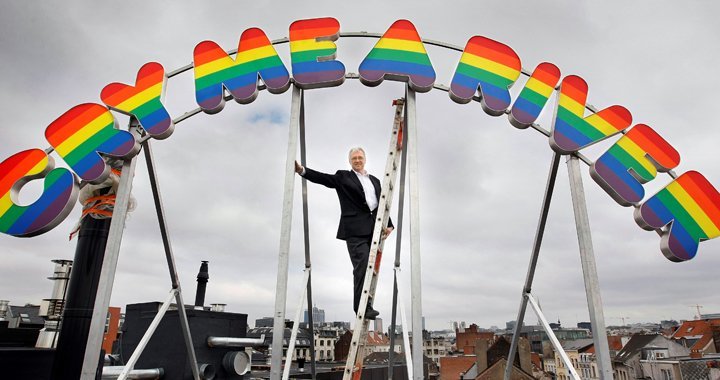
A Story About An Island
An interview with Belgian art collector Walter Vanhaerents in Brussels
15/06/2016
Art collector Walter Vanhaerents' private gallery – all 3,500 square meters of it, located right in the center of Brussels – is a unique institution in the present-day Belgian art scene. And not only because most of the artists represented therein cannot be seen in state museums. Being a professional in the construction business, Vanhaerents is known for his ability to “feel” a space and its relationship with the artworks within it. In the course of our conversation, which took place in Brussels on a rainy day in November of last year, he reveals that it was expressly architecture that “introduced” him to contemporary art. During his architectural travels – the aim of which was to see newly-built museum buildings – he saw something that, to a certain extent, shocked him. “I had been collecting classical pieces for about five years by then. But the art that I saw in these museums had a completely different energy. It changed the way I see things and phenomena.” More than forty years have passed since then, during which Vanhaerents has created what he calls “his own island”. In the world of art, much – perhaps most everything – has changed. But as Vanhaerents says himself: he doesn't like to look backwards; one can get much more joy from the present moment and visions of the future.
The exhibition Heartbreak Hotel took place during the 56th Venice Art Biennale in 2015 – it was the first time that Walter Vanhaerent's art collection was presented to the public outside of Belgium, and in such a profound way, at that. Vanhaerents was in Venice throughout the length of the exhibition's run (from the beginning of May to the middle of September), and he could often be seen in the venue where it was being held, in the Zuecca Project Space on the island of Giudecca. Vanhaerents has always been intrigued by Venice. He wanted to discover how the city functions; how a place that is so rich in classical art could be so open to everything contemporary.
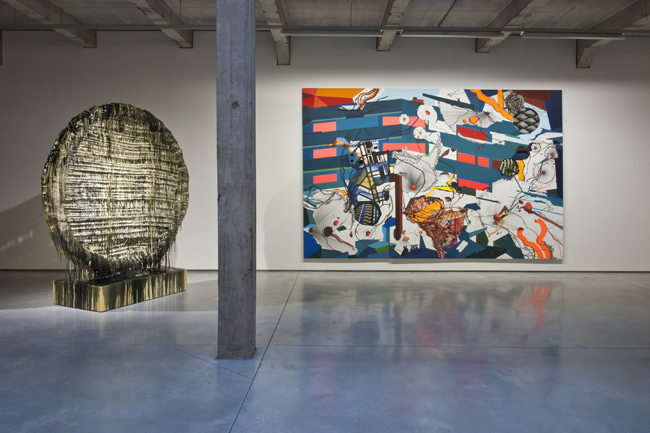
Works of Sterling Ruby and Franz Ackermann. Photo: The Vanhaerents Art Collection
In analyzing the art collector as a phenomenon, the collector and professional psychologist Diethard Leopold once said that collecting is the peculiar act of creating another body, another “me”. Would you agree with that?
For me, it is the expression of my feminine sentimental side, because construction is a very complex and weighty business. I'm looking for a way to find balance in my life; a way to get out of this stressful male territory. I have always been interested in architecture because it is tightly linked to construction. It was architecture that brought me to art – I was traveling to look at contemporary art museum buildings, and I was introduced to a kind of art that I knew nothing about. It was mostly in Germany where I got to know the works of many internationally famous artists. It cardinally altered my worldview.
Yes, when looking at it from this point of view, one can agree that it is a kind of creation of a second world, a chance to find a balance between rationality and sentimentality. I don't know who it was, but someone once said that art is useless. Except for the instances when you want to create your own world, your own island. I often play around with this island idea. I'm fascinated by the fact that I'm patiently building this world myself. It's wonderful – knowing that this is my vision.
Do you believe that art can change the world?
No.
I've heard that you don't like to look back on the past. But still – when you take into consideration these forty years of collecting art, has the art changed you?
I don't think that art has changed me as a person. At least – not much. I've always been very strict, and I have an opinion on what I like, what I love, and why. However, art itself has changed very much over these years. The concept of it, and its relationship to economics and the world of business. Of course, I've spent many years observing these processes... I never imagined that what gives me so much joy could also be financially lucrative. I'm still amazed that, for instance, in my case, the value of my collection is many times more valuable than what I – working for forty-five years, morning to night – could earn. It's unbelievable that something like that has happened.
Today, the artists of the younger generation are very gallant, very polite, ready to oblige and explain. They're integrated into the system – very commercial and oriented towards selling. I think the artists of the older generation communicated in a completely different way. I've even met some who didn't want to talk about their art. It was either very hard for them, or else they were extremely shy. It was like this with Christian Boltanski, who I met many years ago. Back then, for him to go to the openings of his shows, to move the artworks from his studio to a public space – was terrifying. Now everything is completely different. Even Boltanski has changed.
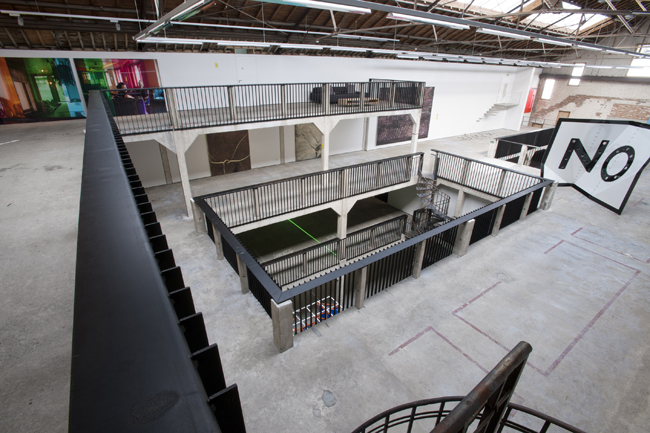
Home of the Vanhaerents Art Collection. © Courtesy of the Artist and Vanhaerents Art Collection
Have the relationships between artists and collectors also changed?
I couldn't say. I haven't had many relationships with artists. One of my closest friends is an artist, but I never buy works from him. The story is not about the artist, but about the artist's art. And you have to be true to to your principles, but you can't do that if your friend is an artist. It seems much easier and more pleasant when you can go to a gallery and meet with someone to whom you can freely express your opinion. And admit if a certain piece doesn't speak to me. But I can't say these things to an artist. That's also why I can't do commissions. I know many collectors who don't acquire artworks until they have met and spoken with the artist. That seems silly to me. There are so many artists I've never met, but whose works I have. It would be nice to sometimes see them face to face, but not for the purpose of making contact, forging a relationship, and then buying art “directly” from them. Many collectors try to bypass galleries. But sometimes, despite having made carefully considered decisions, you realize that you've made the wrong choice. I can talk to the gallery about rectifying the situation, perhaps exchanging the work for another... With an artist, you can't arrange anything like that. But today the contact between the gallerist and the client is always disappearing. You go into a gallery, and there sits a young lady – an administrator, and you can't meet with the gallerist. You'll find him at the art fair.
You mentioned that you're very strict in your choices and opinions. What is it that you're looking for in art?
That's not easy to explain. I'm especially fascinated by three-dimensional phenomena. Sculpture is the art form closest to me because it's very to close to life. Sometimes I don't understand why people create things that are two-dimensional if life is three-dimensional. I acquire only those artworks that I can feel, and with which I have a relationship – the ones that pull me in, grab my attention with something, are able to surprise... I avoid buying art rationally. Pragmatism suits business, not art. That's completely something else. I know people who, before acquiring a work, meticulously weigh all of its aspects: price, physical dimensions, is it appropriate for living quarters... They have very many restrictions.
My goal with this collection has never been money; I don't buy “something” because it may go up in price, and so that I can sell that “something” at a profit. I'm not involved in the art business. My base is the initial market. Besides, I have huge problems with things that have belonged to others. For instance, I never buy works from Saatchi, whose collection is always for sale. Sometimes, knowing my specific interests, I'm offered pieces from it. Just recently, it was works by David Altmejd. I said: “No, I'm never going to buy works from Saatchi.”
Why not?
Because I like to buy and choose artworks myself. Second-hand works... I don't know... they're not as exclusive (laughs). There have been some instances... but I usually make my own choices and it is I that creates my collection. Today, people put together a collection in five years. I've been at it for more than 40 years.
Is there a link between an artwork's price and its quality?
In truth, the artwork's price is an instrument of the market – one that has nothing to do with the artwork.
But to buy, for example, an excellent Kiefer at a lower price isn't even possible...
It's not. And there's no point in buying a not-that-good Kiefer or a not-that-good Pollock, just to have their names in your collection.
You, for example, have several works by Murakami.
But I don't buy Murakami anymore. His first works, of those that I own, were – and in my opinion, still are – very significant phenomena. “My Lonesome Cowboy”, which I have, is one out of just a couple dozen masterpieces of contemporary art. In the beginning, Murakami was so fresh and inspiring! But later on... I've never bought any of his paintings or those knickknacks that are now being made...
The decision to acquire an artwork is made only by you, alone?
It is my small island, and I don't allow others to stay on it. I've created it over these years, and I have become convinced that I can handle it all by myself. It required a lot of patience on my part; I had to learn and I had to do a lot of observing and training of my visual perception. That was my education – viewing. Of course, my wife has always been my companion, but not the decision-maker. I don't think that a collection can be put together by two people. It's accepted as being very stylish nowadays – “as a couple we are equal partners and collectors”. But I don't believe it. There's always just one collector.
Are there any basic tenets that you observe when creating your collection?
I have no restrictions. The medium an artist uses seems important to me. I believe a message can be expressed in a myriad of ways, and it's important to me which instrument an artist uses – painting, sculpture, drawing, etc.
There's just one principle that I follow, which I devised for myself a long time ago: I don't wish to go back in time. For instance, I don't buy art from the 60s or 70s – even if I like it. I'm fascinated by the opportunity to be here and now, and I'm inspired by looking into the future. I'm a person of the future. In my exhibitions, I tend to create dialogs between the past and the present; sometimes – I confront items from my collection.
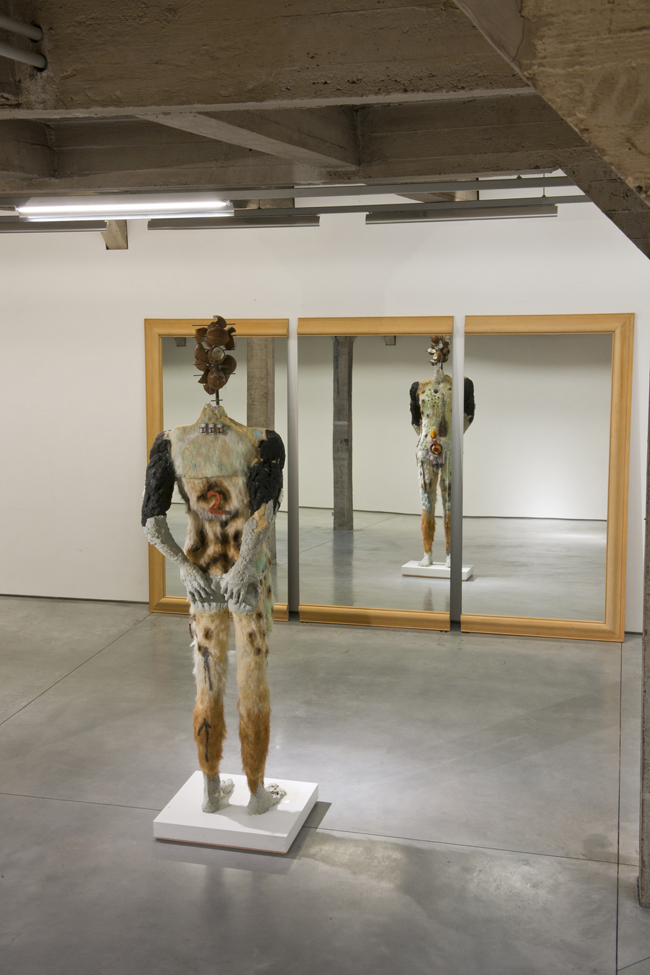
Group Show Man in the Mirror. Michelangelo Pistolletto & David Altmejd. © Courtesy of the Artist and Vanhaerents Art Collection
You almost always curate the exhibitions of your collection yourself – that's quite a brave step. What is it that draws you into doing this?
I've seen thousands of exhibitions, and I've always been especially interested in the way that they're put together. The way in which the display is built. It's probably connected to my professional business. I often think how I would have done something, how it could have been done differently. Over time, I've accrued a load of knowledge and ruminations. It's boring if things are just hung up on a wall, if there isn't any interaction among the works. When, in 2007, I decided for the first time to organize a public exhibition of my collection, I said: “I'm doing it myself – I'll be the curator.” That was truly a challenge, and also an unnerving process because as it turned out, to do something like that is much harder than I had imagined (laughs). Actually, the work of creating a mutual relationship between a space and art is like creating a new language. Since then I've been working with other curators. But I really like doing it. Collectors don't put themselves in this position all that often. They usually work in a team, or invite a curator – which is also great, because then other people also get to know the collection.
In 2015 you showed your collection outside of Belgium for the first time – in Venice, during the Art Biennale. You also lived there throughout the many months that the exhibition was going on. Why did you decided to do that?
Venice has always been a city that has intrigued me. I wanted to understand it, how it all functions. How can a place that is so rich in classical art be so open to everything contemporary? What is this energy that lives there? And not only in terms of visual art, but also in cinema, dance, music. It's evident that this city does not need all of that. It has everything – churches, museums... Why doesn't something like that go on in Rome or other big cities? Usually, the more classical riches a city is endowed with, the less apt it is to accept contemporary culture. Like in Bruges, which is close to where I live, and where no one wants to create contemporary art. “We're a medieval city, we don't need anything like that.” That's why Venice delights me, and I still think that the Biennale is the most important exhibition in the world. I didn't expect that my collection would receive so much attention. I even met people from Belgium and the Netherlands there – our proximity notwithstanding, they had never been to see us in Brussels. Yet they found us in Venice. National representation in the context of the Biennale is another issue.
Taking into account the globalization of today's world, is nationality even relevant today?
In truth, I don't really believe in the kind of national art that is being shown in Venice – where many countries are being represented by artists that have barely any connection to them. In a sense, it's even a bit silly. I think the idea of pavilions as such should be rethought. Started from anew. I feel there should be an institution, like a selection committee, that evaluates what each pavilion has to offer. One gets a bit frustrated when you see that, for instance, Chinese artists are representing a country with which they have no connection. And sometimes the presentations are very weak. In truth, the national aspect of art doesn't concern me.
Nevertheless, I understand you have a special relationship with Germany.
They have excellent museums – for instance, in Cologne there's an excellent collection of pop art that nobody knows about. I used to go to Germany often. Not to look at German art specifically, per se, but because it was a highly energized territory. And it still is, isn't it? Angela Merkel is on the cover of Time magazine. I still look upon this country with great interest. It was able to birth itself anew from the rubble of war, and become the most important country in Europe. Nevertheless, my goal has never been to collect German art specifically.
Richter and Beuys have great meaning for you, however.
Yes, but it's not as if the Germans have had a decisive role in the forming of my opinions. Just as meaningful, for example, was pop art, which I discovered at the Museum Ludwig. It's so easy to compare Germany with the United States, another world power. They are both linked with openness. And it is precisely this open vision that interests me. The shamanistic way of expression with which Warhol was able to leave an impression fascinated me. I discovered him thanks to the movies, because during my college days I was obsessed with cinema, and I also wrote film reviews. That was the 70s. After that I quickly entered a phase I call “post-Warholian” – it's an interesting part of my collecting history. Cindy Sherman, Barabara Kruger, Jenny Holzer – artists who are around sixty years old now.
How large is your collection now?
I'm not going to tell you (chuckles). That's something I don't reveal to anyone; it's a part of my mystery. First of all, because I don't know. Second of all, I think more in terms of quality than quantity. But I do have very many items, and very many large items. If I were to show everything on the internet (like Saatchi), then it would lose this feeling of freshness, its interest. I want people to come here, after all.
During our conversation, you have several times characterized your collection as a single island that belongs to you alone. How did you come to the decision to publicly show it?
Actually, that was never in my plans. It was the random confluence of several factors. The first idea was something similar to an open warehouse, and I hope we'll still realize this plan. But then I ended up here, in Brussels, and I saw this space... Some things come from God... You start out with something very private, that is just for you alone, but then artists and gallerists start telling you that you have a wonderful collection – why not show it to others? So, step by step...
Do you have the wish to surprise others?
Yes, but the number of people is not the determinant thing. Only those who are truly interested. I want them to fully enjoy the quality and mutual interaction between the building and the art. That is very important to me. I used to do a little studying of the idea behind Ingvild Goetz's art space in Munich. At first, she didn't even want to show her wonderful collection to anyone, but in the end she couldn't refuse anymore because various people wanted to see it.
I know that now, it's possible to see everything on the internet, and there's no need to even go anywhere. When Art Basel Miami was going on, I looked at everything on the net. And people are doing this increasingly more – they look at art on their computer screens. But here, we have a glass of wine together, we chat, we discuss. And I find that's necessary for me; it seems important. The personal contact. At the exhibition in Venice, that also seemed the most significant part of it. And people go away the richer for it.
At the beginning of our conversation, you described yourself as a person of the future. What do you imagine art will be like in the future?
Today, the concept of “a work of art” is unbelievably broad. Everything is art. Supposedly, anyone who says they are an artist can be an artist. Back when I began my professional career, I had to prove that I could do it at a professional level. Artists have total freedom. But I don't think that anyone can say where that will take us. It's a mystery. It's glaringly visible that artists have become individualists. There are no longer artist unions or groups – such collective bodies don't exist. At the same time, the art world is spread out and, at times, incomprehensible – even to me, who is supposedly so familiar with it. But one thing about the future is abundantly clear – no more than two percent of all of today's artists will go down in world history. How many of them are there today? A million? Do you have any idea?
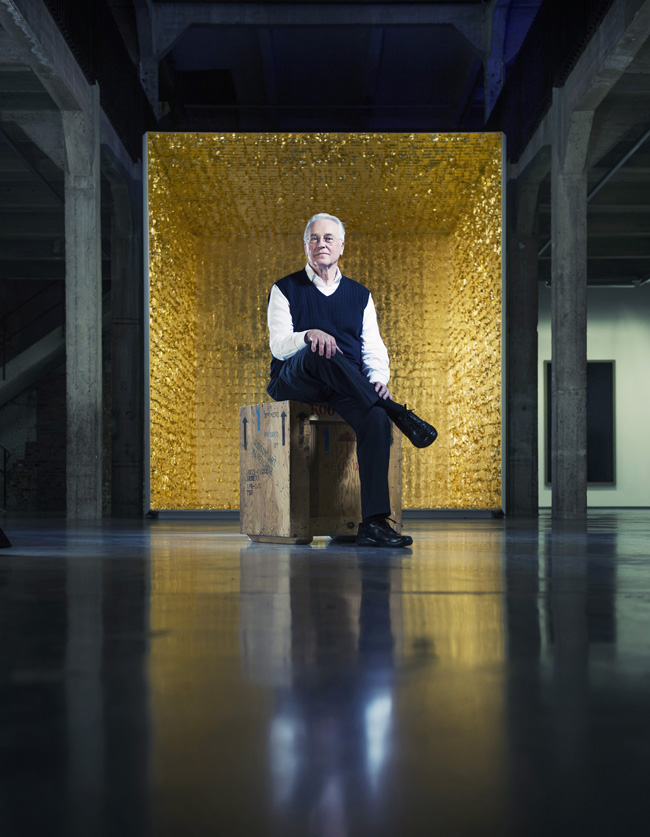
Walter Vanhaerents. Photo: Karel Duerinckx
No, I don't. But on the topic of the future, is it meaningful to you that your children have also become collectors?
Actually, I never thought that would happen. Of course, they were always with me when I went to view art. My grandchildren live a completely different life now – they go on excursions in the city, they go see various events and attractions. My children didn't have those opportunities. They always had to go see art. From morning to night. And I never dared to hope that they would have a need for art in their adult lives. Because they used to say – we've suffered through enough. But now they both collect art. I'm happy that now we can combine forces. The first time this happened was last summer, in Venice. And we're hoping to work together again soon. But as I've noticed here, in Belgium, once a collector dies, a year later his collection appears on the market. And it happens often. But art doesn't die because of that. It simply ends up with other collectors.
Belgium has a very vibrant and powerful group of art collectors.
Yes, it really does. Especially in the east of Flanders. I think it has the highest concentration of collectors per square kilometer in all of Europe. And many are unknown. That's the most interesting thing. I'm also from there. When we gather here, people tell me about their art collections. And sometimes that's quite a surprise, because no one even knew they had a collection. I'm not a judge that can evaluate the notability of these collections, but it's very interesting nonetheless. One could say that the Belgian art collectors are like an “underground” phenomena, because they're not doing it for someone else – they're doing it for themselves. You may be ready to show it to someone else, to share the collection, but you're never going to create it for someone else.
Do you have any pieces from the collection in your home?
Yes, but just a few works. I don't want to keep a whole bunch there, but every once in a while I switch them around. Of course, I always have the option to come here. And after all, my apartment is right above this exhibition space. I can come down in my pajamas to have a cup of coffee.